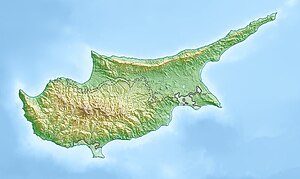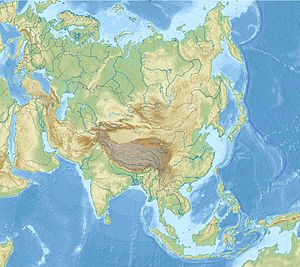Kyrenia
| |
|---|---|
City and municipality | |
Kyrenia Harbour Kyrenia Castle exterior View of Kyrenia from Bellapais Monastery View of Kyrenia from St Hilarion Castle | |
 Interactive map outlining Kyrenia | |
| Coordinates: 35°20′25″N 33°19′09″E / 35.34028°N 33.31917°E | |
| Country (de jure) | |
| • District | Kyrenia District |
| Country (de facto) | |
| • District | Girne District |
| Government | |
| • Mayor | Murat Şenkul[2] (in Kyrenia) Violaris Iosif (in exile) |
| Area | |
| • Kyrenia | 10.47 km2 (4.04 sq mi) |
| • Municipality | 52.59 km2 (20.31 sq mi) |
| • District | 690 km2 (270 sq mi) |
| Elevation | 0 m (0 ft) |
| Population | |
| • Kyrenia | 22,148 |
| • Municipality | 45,881 |
| • Municipality density | 870/km2 (2,300/sq mi) |
| • District | 96,663 |
| Time zone | UTC+2 (EET) |
| • Summer (DST) | UTC+3 (EEST) |
| Website | Kyrenia Turkish Municipality Northern Cyprus eGov portal Kyrenia Municipality(in exile) |
Kyrenia[a] is a city on the northern coast of Cyprus, noted for its historic harbour and castle. It is under the de facto control of Northern Cyprus.
While there is evidence showing that the wider region of Kyrenia has been populated before, the city was built by the Greeks named Achaeans from the Peloponnese after the Trojan War (1300 BC). According to Greek mythology, Kyrenia was founded by the Achaeans Cepheus and Praxandrus who ended up there after the Trojan War. The heroes gave to the new city the name of their city of Kyrenia located in Achaia, Greece.
As the town grew prosperous, the Romans established the foundations of its castle in the 1st century AD. Kyrenia grew in importance after the 9th century due to the safety offered by the castle, and played a pivotal role under the Lusignan rule as the city never capitulated. The castle has been most recently modified by the Venetians in the 15th century, but the city surrendered to the Ottoman Empire in 1571.
The city's population was almost equally divided between Muslims and Christians in 1831, with a slight Muslim majority. However, with the advent of British rule, many Turkish Cypriots fled to Anatolia, and the town came to be predominantly inhabited by Greek Cypriots. While the city suffered little intercommunal violence, its Greek Cypriot inhabitants, numbering around 2,650, fled or were forcefully displaced in the wake of the Turkish invasion in 1974. Currently, the city is populated by Turkish Cypriots, mainland Turkish settlers, and British expats, with a municipal population of 33,207.
Kyrenia is a cultural and economical centre, described as the tourism capital of Northern Cyprus.[6][7][8] It is home to numerous hotels, nightlife and a port. It hosts an annual culture and arts festival with hundreds of participating artists and performers and is home to three universities with a student population around 14,000.[9]
- ^ In 1983, the Turkish Republic of Northern Cyprus unilaterally declared independence from the Republic of Cyprus. The de facto state is not recognised by any UN state except Turkey.
- ^ Northern Cyprus High Election Board [Northern Cyprus High Election Board], Northern Cyprus High Election Board
- ^ "Northern Cyprus: Districts, Major Towns & Villages - Population Statistics, Maps, Charts, Weather and Web Information". www.citypopulation.de. Retrieved 8 October 2024.
- ^ "Northern Cyprus: Districts, Major Towns & Villages - Population Statistics, Maps, Charts, Weather and Web Information". www.citypopulation.de. Retrieved 8 October 2024.
- ^ KKTC Yerel Yönetimler Raporu 2019 [TRNC Regional Administrations Report 2019] (PDF), TRNC State Planning Organization, December 2020, p. 4
- ^ Şahin, Sanem (2011). "Open borders, closed minds: The discursive construction of national identity in North Cyprus" (PDF). Media, Culture & Society. 33 (4): 583–597. doi:10.1177/0163443711398694. S2CID 42106005. Retrieved 10 July 2016.
- ^ Fındık, Ünal (1998). "Örnek olaylarla belediyecilik: II. Girne Kent Kurultayı" (PDF). Çağdaş Yerel Yönetimler (in Turkish). 7 (1): 116–122. Archived from the original (PDF) on 27 January 2017. Retrieved 10 July 2016.
Girne, Kuzey Kıbrıs Türk Cumhuriyeti'nin turizm başkenti olarak anılmaktadır.
- ^ A number of press reports, including:
Diyalog: "Kuzey Kıbrıs'ın turizm başkenti Girne'de"
Hürriyet: "Girne, Kuzey Kıbrıs’ın ‘’turizm başkenti.’’"
Kıbrıs: Google Search result - ^ [1] Archived 3 January 2015 at the Wayback Machine
Cite error: There are <ref group=lower-alpha> tags or {{efn}} templates on this page, but the references will not show without a {{reflist|group=lower-alpha}} template or {{notelist}} template (see the help page).








